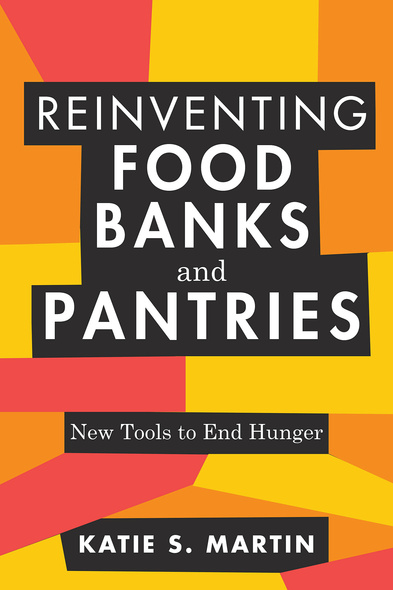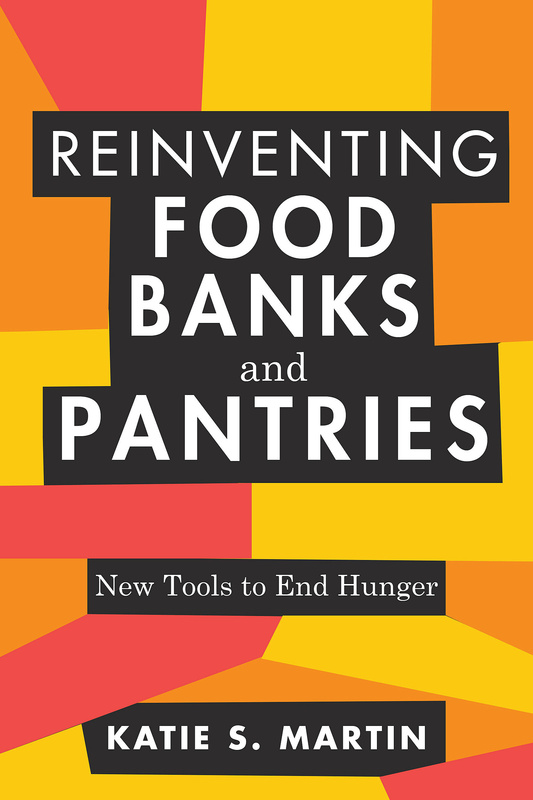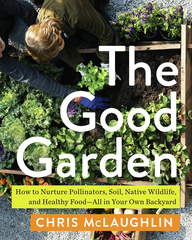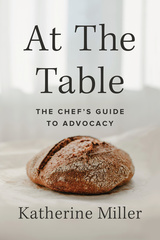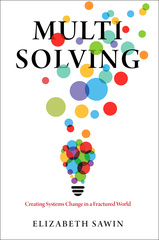In the US, there is a wide-ranging network of at least 370 food banks, and more than 60,000 hunger-relief organizations such as food pantries and meal programs. These groups provide billions of meals a year to people in need. And yet hunger still affects one in nine Americans. What are we doing wrong?
In Reinventing Food Banks and Pantries, Katie Martin argues that if handing out more and more food was the answer, we would have solved the problem of hunger decades ago. Martin instead presents a new model for charitable food, one where success is measured not by pounds of food distributed but by lives changed. The key is to focus on the root causes of hunger. When we shift our attention to strategies that build empathy, equity, and political will, we can implement real solutions.
Martin shares those solutions in a warm, engaging style, with simple steps that anyone working or volunteering at a food bank or pantry can take today. Some are short-term strategies to create a more dignified experience for food pantry clients: providing client choice, where individuals select their own food, or redesigning a waiting room with better seating and a designated greeter. Some are longer-term: increasing the supply of healthy food, offering job training programs, or connecting clients to other social services. And some are big picture: joining the fight for living wages and a stronger social safety net.
These strategies are illustrated through inspiring success stories and backed up by scientific research. Throughout, readers will find a wealth of proven ideas to make their charitable food organizations more empathetic and more effective. As Martin writes, it takes more than food to end hunger. Picking up this insightful, lively book is a great first step.
In Reinventing Food Banks and Pantries, Katie Martin argues that if handing out more and more food was the answer, we would have solved the problem of hunger decades ago. Martin instead presents a new model for charitable food, one where success is measured not by pounds of food distributed but by lives changed. The key is to focus on the root causes of hunger. When we shift our attention to strategies that build empathy, equity, and political will, we can implement real solutions.
Martin shares those solutions in a warm, engaging style, with simple steps that anyone working or volunteering at a food bank or pantry can take today. Some are short-term strategies to create a more dignified experience for food pantry clients: providing client choice, where individuals select their own food, or redesigning a waiting room with better seating and a designated greeter. Some are longer-term: increasing the supply of healthy food, offering job training programs, or connecting clients to other social services. And some are big picture: joining the fight for living wages and a stronger social safety net.
These strategies are illustrated through inspiring success stories and backed up by scientific research. Throughout, readers will find a wealth of proven ideas to make their charitable food organizations more empathetic and more effective. As Martin writes, it takes more than food to end hunger. Picking up this insightful, lively book is a great first step.
In her new book, Reinventing Food Banks and Pantries: New Tools to End Hunger, Katie S. Martin... offers a blueprint for change. She provides a thoughtful guide for transforming food-focused charities into centers of community empowerment that foster long-term stability and advocates for a paradigm shift away from the notion of hunger as a short-term emergency....[The book] provides historical context, data-driven examples of particularly effective organizations, and a clear eye toward the future.
The book is written in a conversational and accessible style. Action steps provided at the end of each chapter can guide practitioners in the charitable food network. Each chapter also includes a bibliography of useful resources.
[Reinventing Food Banks and Pantries] focuses on the kinds of strategies that lend to client empowerment, promoting a new way of designing food banks and pantries to be not just more accessible, but more widely supportive of nutrition and other social services for the needy.... No social issues collection should be without this practical assessment of food distribution choices and their accompanying potential for community support and change.
Katie’s book sets a course with a hunger free America as True North. It goes beyond the oft-expressed and data-informed premise that food insecurity is a symptom of a complex mix of endemic challenges that people facing hunger must confront. This book attempts to tackle some of them head-on by chronicling promising practices that give us reason to hope that sustainably positive outcomes are within our grasp should we dare to seize them.’
Katie Martin argues persuasively that it is time to shift from short term food transactions to systems change. Her vision so resonates with all I’ve learned through my own hunger work at the United Nations, the Capital Area Food Bank, and now at PHA. Food equity is health equity. We can and must do better.’
Katie Martin, PhD, is the CEO of More Than Food Consulting, LLC whose goal is to advance organizational and systems change in the charitable food system to ensure people have economic and nutrition security. She is recognized as a thought leader on food security issues and has over 25 years of experience developing and evaluating programs to promote health, stability and financial wellbeing. She earned a Ph.D. in Nutrition Science & Policy from Tufts University. Katie is happily married, is the proud mom of two sons, and blessed to be a host parent for an exchange student from Nigeria.
Preface
Chapter 1. Introduction
Chapter 2. History of Food Assistance Programs
Chapter 3. A Paradigm Shift in How We Talk about Hunger
Chapter 4. A Welcoming Culture
Chapter 5.The Dignity of Choice
Chapter 6. Promotion of Healthy Food
Chapter 7. Connection to Community Services
Chapter 8. The Vital Role of Volunteers
Chapter 9. Evaluation: What Gets Measured Gets Done
Chapter 10. Structural Inequalities and Systems Change
Chapter 11. Equity within Food Banks and Pantries
Chapter 12. New Partners and Community Food Hubs
Chapter 13. Conclusion: Take One Step
About the Author
Chapter 1. Introduction
Chapter 2. History of Food Assistance Programs
Chapter 3. A Paradigm Shift in How We Talk about Hunger
Chapter 4. A Welcoming Culture
Chapter 5.The Dignity of Choice
Chapter 6. Promotion of Healthy Food
Chapter 7. Connection to Community Services
Chapter 8. The Vital Role of Volunteers
Chapter 9. Evaluation: What Gets Measured Gets Done
Chapter 10. Structural Inequalities and Systems Change
Chapter 11. Equity within Food Banks and Pantries
Chapter 12. New Partners and Community Food Hubs
Chapter 13. Conclusion: Take One Step
About the Author

